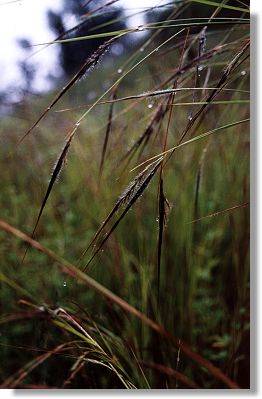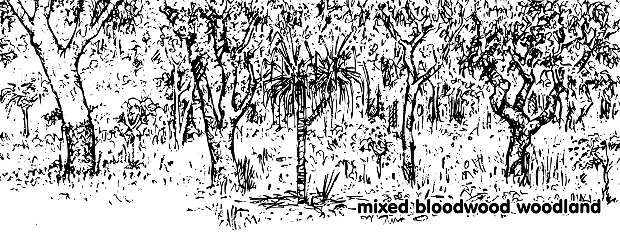Mixed Bloodwood Woodland
Bloodwood woodland is one of the most widespread vegetation communities on the lowlands of Magnetic Island. The vegetation here would be similar to the Picnic Bay of 150 years ago.
The main eucalypt species here are Moreton Bay ash (Corymbia tessellaris) and coastal bloodwood (Corymbia clarksoniana). Other species include beach wattle (Acacia crassicarpa), native ebony (Diospyros geminata), beach tuckeroo (Cupaniopsis anacardioides), red ash (Alphitonia excelsa), mango bark (Canarium australianum) and a few large weeping paperbarks (Melaleuca leucadendra).
 |
Black Spear Grass (Heteropogon contortus) |
| |
Native grasses are an important part of open woodlands. Kangaroo grass (Themeda triandra) and black spear grass (Heteropogon contortus), which are typical of undisturbed open bloodwood woodland, can be seen here. Another interesting ground cover is the scarlet bloodroot (Haemodorum coccineum), which emerges from an underground tuber early in the wet season. This beautiful red lily is similar to the southern kangaroo paw and is common in the undisturbed sandy granitic soils of the lowlands.
Historically, this vegetation community would have been managed by a regular Aboriginal fire regime. Since European settlement regular burning has ceased and many woodlands are becoming less open and subject to invasion by deciduous softwood and vine-thicket species. Management agencies, such as the Townsville City Council and Queensland Parks and Wildlife Service, use selective mowing, hand weeding and fire to maintain open woodlands with a native grass understorey.
Termites play an important role in the open woodlands of the dry tropics as recyclers of nutrients. In the wetter tropical and temperate areas, fungi, earthworms and grubs of various beetles decompose nutrients. Due to the lack of available moisture in the dry tropics, leaf and branch litter does not decompose; instead, it becomes extremely dry and provides a high fuel load. Termites are able to break down the lignin and cellulose, which are the main components of the dry woody debris. This is an important part of the topsoil-forming process. The underground tunnels produced help to aerate the soil and allow moisture penetration deeper into the soil profile, allowing plant roots to penetrate deeper in hard or compacted soil.
Termites are also responsible for the hollow-forming process in the eucalypts of northern Australia. These hollows are used by many animals for nesting and shelter, including brushtail possums (Trichosurus vulpecula), rainbow lorikeets (Trichoglossus haematodus), red-winged parrots (Aprosmictus erythropterus) and kookaburras (Dacelo spp.), examples of which can be seen within these grounds. |
